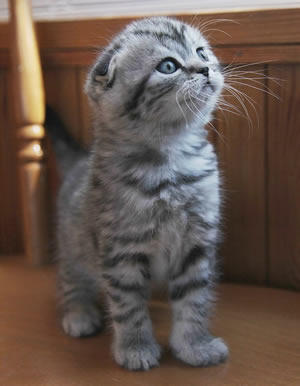Breed Standard
Head: Round. Domed forehead. Rounded cheeks. Jowls allowed in adult males. Broad, short nose. Slight stop accepted. Well-rounded muzzle. Round whisker pad. Firm chin.
Eyes: Large, round, fairly well-spaced. The color corresponds to that of the coat.
Neck: Short and muscular.
Body: Medium-sized, stout, rounded, very muscular. Medium-boned.
Paw: Length in proportion to the body. Medium-boned. Round, compact paws.
Tail: No longer than 2/3 the length of the body. Thick at the base, tapering to a rounded tip. Very supple and flexible.
Coat: Two varieties: - short, thick, tight, very dense, fluffy, resilient coat - semilong: This variety is called the Highland Fold. All colors are recognized. Chocolate, lilac, and Siamese markings are not allowed.
Fault: Head too slender, pointed. Stop too pronounced. Disqualify: tail too short, lacking flexibility due to abnormally thick vertebrae.
History
A roly-poly guy with little ears set in a caplike fashion, flat against the head In his 1897 Treatise on Animal Breeding, Professor Cornevin indicated a breed of shorthaired cat with pendulous ears that was fattened for eating in its native China. A spontaneous mutation by a dominant gene that caused the ear flap to fold forward was first observed in Scotland in 1961. William Ross, a shepherd in Tayside, and his wife Mary noticed a white female cat named Susie with folded ears who lived at the McRae family's neighboring farm. Susie gave birth to Snooks, a white female with the same type of ears. When crossed with a British Shorthair, she gave birth to a white male named Snowball. This new breed was named after the “folded ear” mutation. Unfortunately, limb, tail, and joint deformities linked to the dominant Fd gene appeared, to such an extent that the G.C.C.F. discontinued registration of the breed in 1973. In 1971, Mary Ross sent some Scottish Folds to Neil Todd, an American geneticist in Massachusetts who set about breeding the cats again. Crosses were made with British Shorthairs, Exotic Shorthairs, and American Shorthairs in order to prevent severe joint disorders.The C.F.A. and then T.I.C.A. recognized the breed, which was highly successful in the United States. A return to Europe began in 1980, with the first Scottish Fold born in France in 1982. Recognized neither by the F.I.Fe. nor the G.C.C.F., the Scottish Fold is relatively rare throughout Europe. In the United States, a Scottish Fold was crossed with a Persian to produce a new, longhaired version called the Highland Fold or Longhaired Scottish Fold, which is recognized by T.I.C.A. A cross with rexes made in Germany in 1987 gave rise to the Pudelkatze or Poodle Cat, a curly-coated feline with pendulous ears. With a very limited population, the Pudelkatze is not yet recognized as a new breed.
Behavior
Scottish Folds are especially peaceful, non-dominant, and friendly toward other cats and toward dogs. Gentle, very affectionate, loving, and very playful, they adore family life. They are discrete and have a soft voice. Hardy and resistant, these cats are excellent hunters. In terms of grooming, they require weekly brushing. During shedding, their fluffy coat must be combed regularly. It is best to keep an eye on their ears. In order to prevent bone deformities, two cats with folded ears should not be mated together. Instead, the Scottish Fold is crossed with prick-eared cats like the British Shorthair or American Shorthair. The "folded ear" characteristic is not visible until the third or fourth week, and the degree of folding cannot be observed until the fifth or sixth week.
Health
Scottish folds are susceptible to polycystic kidney disease (PKD) and cardiomyopathy. Scottish folds are also prone to degenerative joint disease (a type of arthritis), most commonly affecting the tail, ankles, and knees which can result in reduced range of motion.






